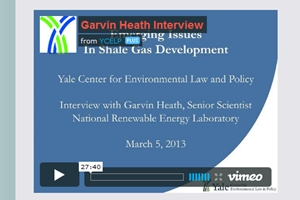
On shale Gas and climate change
By Bruce Ho
On Tuesday, March 5, I caught up with Dr. Garvin Heath, a senior scientist at the U.S. Department of Energy’s National Renewable Energy Laboratory (NREL), to discuss research that he recently completed on the lifecycle greenhouse gas emissions from shale gas produced from Texas’ Barnett Shale.
Dr. Heath’s research is part of the same Joint Institute for Strategic Energy Analysis (JISEA) report on “Natural Gas and the Transformation of the U.S. Energy Sector: Electricity” that his NREL colleague Jeffrey Logan discussed as part of the Yale Center for Environmental Law and Policy’s Policy Workshop Webinar Series on Emerging Issues in Shale Gas Development last month. Dr. Heath’s work also provides additional perspective and data on the shale gas-climate change links that Environmental Defense Fund scientist Dr. Ramon Alvarez discussed with our Center in his webinar last fall.
You can listen to my interview with Dr. Heath and view some slides that he prepared on his research below. You can also download his slides separately from the interview here.
As Dr. Heath notes in the interview, some key findings from his research include:
Lifecycle greenhouse gas emissions from electricity generated using gas produced from Texas’ Barnett Shale in 2009 were comparable to the lifecycle emissions estimated for electricity generated using conventionally produced natural gas (i.e., shale gas from the Barnett appeared to be no worse for the climate than conventionally produced gas).
10-20 percent of shale gas’ lifecycle greenhouse gas emissions occurred prior to gas combustion at power plants, and these pre-power plant, upstream emissions were evenly split (in global warming-normalized “carbon-dioxide equivalent” terms) between methane leakage and upstream carbon dioxide emissions from gas “beneficially used” in the supply chain to run compressors and other equipment.
Many of these upstream emissions could potentially be eliminated, such as by reducing or preventing methane leakage or improving equipment efficiencies to reduce the amount of gas that must be combusted to run upstream equipment.
There are still significant uncertainties in shale gas’ lifecycle greenhouse gas emissions due to data gaps and uncertainties in areas such as the actual gas-use efficiencies of upstream equipment, which are based on relatively limited data sets.
Additionally, there remain problems in matching the results from “bottom-up” lifecycle analyses, such as the one performed by Dr. Heath for the JISEA report, with those from “top-down” atmospheric measurements, which find methane concentrations that are significantly higher than the bottom-up analyses would suggest. These atmospheric measurements, which tell us the true levels of methane present, suggest that methane leakage from shale gas (and conventional gas) may be higher than we know, though researchers have not yet been able attribute this atmospheric methane to specific, on-the-ground sources (i.e., individual gas wells or other sources).
To learn more about this research and that of Dr. Heath's colleagues, you can download the full JISEA report here. In addition to Dr. Heath’s lifecycle emissions assessment (Chapter 1 of the report), the JISEA report also includes information on shale gas development’s legal and regulatory frameworks (Chapter 2; see also Professor Hannah Wiseman’s webinar from last December), water-related practices (Chapter 3), and electric power futures (Chapter 4; see also Jeffrey Logan’s webinar on this chapter from last month).
Posted in: Environmental Performance Measurement • Environmental Law & Governance • Energy & Climate •


































